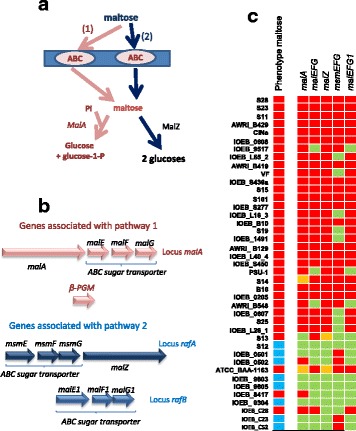Fig. 8.

Maltose degradation. a Putative maltose specific catabolic pathways. MalA: maltose-phosphorylase, MalZ: alpha-glucosidase, a, b, c sugar permease. Glucose and glucose-1-P then follow the pathways described in Fig. 4. b Organization of the genes clusters putatively associated with maltose catabolism. c Genotype/phenotype correlations. Strains are listed according to the phylogenomic dendrogram (Additional file 2: Figure S2). In the lane describing the phenotypes, the blue color indicates the strains able to grow on maltose as the sole carbon source, and the red color indicates the strains unable to grow in such conditions. In the lanes for genotypes, a red box indicates that the gene or one of the genes in operons is truncated or appears as a pseudogene. The green box indicates no gene truncation but mutations still can lead to inactive proteins. An orange box indicates that the corresponding genome sequences displays a specific mutation leading to a singular protein. The β-PGM gene is highly conserved and does not appear in this table
